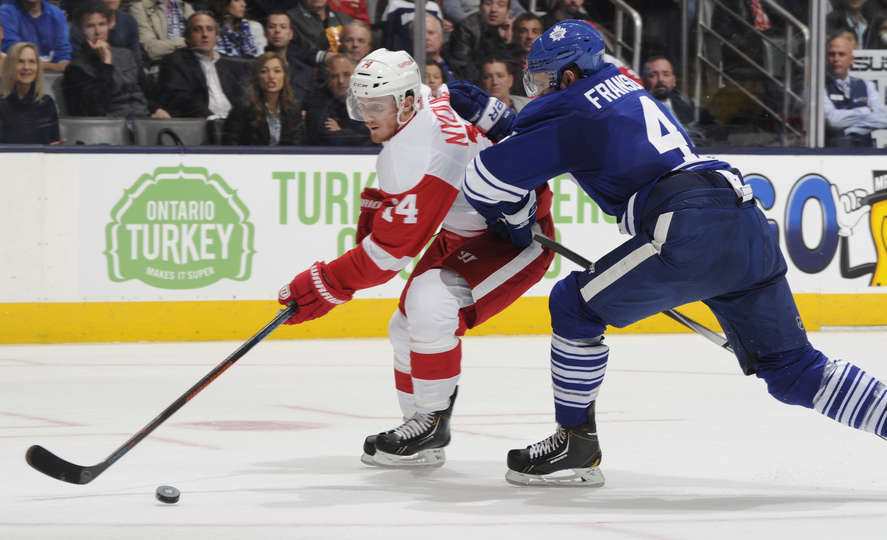Since the 2014-2015 season began, I have been tracking my own internal metrics on Leafs games.
I thought I’d take the time to explain what it is I’m keeping record of and what I am hoping to accomplish by doing so. If you do not care and just want to read notes, quotes and ‘5 Things I think I’d Do,’ just scroll down and skip this part; otherwise, read on to learn more about what we are doing here at MLHS to take things (hopefully) to the next level.
Corey Sznajder’s zone entry and exit work was released over the summer, and I believe there are a few things I can add to the tracking in order to enhance the value presented. Corey did excellent work and was appropriately hired because of it, so I don’t want to take anything away from him, but having looked at the data there are things I will do differently. Corey broke down entries into three separate categories —carries, dump-ins and failed entries — and then within each he would count how many shots were generated via a player’s entry before splitting it all into percentages.
Immediately, I have added a new category to this: dump-ins retrieved. Many teams implement soft chips off the wall to the corner of the zone forechecks (the Kings are excellent at it). That needs to be included in order to provide a full picture. You either enter the zone cleanly or not, dump it and lose it, or dump it and retrieve it. Shots resulting in the entry were also calculated; I will not be doing that, however. I do not know if an explanation of how that was calculated was ever provided. As far as I know — if, for example, Phil Kessel enters the zone cleanly and sets up Tyler Bozak and Bozak messes up, Kessel does not get a “shot per entry” recorded on his totals. Thus, regardless of the fault of the play not lying with Kessel, he won’t be rewarded. I don’t think we can associate shots per entry with an individual because there is a lot of grey area and it does not provide value in terms of evaluating an individual. If a player is successfully entering the zone with regularity, it will show up in his shot count, Corsi, and scoring opportunities.
I also added in neutral zone turnovers for and against to better help understand what is happening in the most important area of the ice.
Neutral zone turnovers also play into zone exits. I account for chips off the glass that the opposing team retrieves in the neutral zone as both an exit and a neutral zone turnover. Thus far, it has been an effective method to help pick out who is getting the puck out and giving it away in the process.
Zone entries against are recorded the same way zone entries for are, but obviously in reverse.
Zone exits, however, I am doing a little differently. Corey tracked touches, skate-outs, pass-outs, “other,” turnovers, and icings. I am choosing not to track touches; there is a lot of grey area there, as it does not specify whether something positive or negative occurred. A “touch” could be a D-to-D pass, which is good, or it could be losing a battle in the corner, which is bad. I can’t throw it all into one category. I’ve added ‘dump-ins against retrieved’ in order to see who is getting worked in the corners immediately and possibly on purpose.
The most important thing I have included, I believe, is “exit assists.” Exits often involve multiple players and I think they all need to get credit when they contribute to a positive breakout. If Rielly forces a dump in, beats the forecheck and gets the puck over to Gardiner, who is then able to skate it out freely, the real heart of the work for that zone exit came from Morgan Rielly and he should appropriately be rewarded. The biggest challenge will be to not give out “exit assists” too liberally, so I try to limit it to one assist per exit. Overall, I think this is a very effective method for figuring out who is doing the heavy lifting.
And, really, that is what this is all about. We want to find out who is a bus driver and who is a bus rider. There is no single number here that tells us everything we need to know, but we can use all of these numbers to paint pictures of what is happening all over the ice, combining them with other numbers to arrive at great detail when analyzing this team.
This is supplemented by the scoring chance data Evan Dorey from Blue and White Disease is posting on MLHS after each game, the WOWY work (among other things) David Johnson is contributing to the site, on top of the content Alec and Declan regularly provide, plus the great analysis we get whenever we are lucky enough to have Gus Katsaros to stop by.
I don’t know when, or how often, I’ll release the data, so that will be one of the next steps (on top of continually tracking games, of course). It is early in the data collection process, but here are some early observations:
1 – Roman Polak is excellent at stepping up in the neutral zone and halting zone entries as well as forcing dump-ins, yet he has the lowest zone start percentage on the team. Another player who is great at stepping up at the blue line? Cody Franson. Stephane Robidas has been allowing a lot of entries early, while placing Franson with Phaneuf has swung Phaneuf’s numbers the other way in large part because of Franson’s ability to prevent clean entries so far.
2 – Komarov is a high impact player all over the ice. He is effective at exiting the zone, he creates neutral zone turnovers, and he can enter the offensive zone both cleanly and forecheck off dump-ins and retrieve it himself. Santorelli is another player who is effective at creating neutral zone turnovers, usually off of the backcheck. Komarov is known as a player “who does the little things right” and I think a lot of that shows up in this data set.
3 – Winnik is excellent at zone entries, much like Komarov, either cleanly or on the forecheck. The Lupul-Kadri-Winnik line has had a successful start to the year possession wise and a lot of it has to do with how Winnik is able to enter the zone regularly with the puck.
4 – Unsurprisingly, Stuart Percy is very high up in the “exit assists” category. He has a mix of D-to-D passes, hitting the center up the middle, or hitting his winger outlets off the rush, on top of his ability to skate the puck out himself.
5 – I don’t know if he is instructed to do this, but Morgan Rielly has a propensity for rushing up ice and then wiring the puck in on a dump-in that the other team easily retrieves. Taking a few extra strides, and attempting a shot that is A) Saved, B) Creates a rebound, or C) Is deflected out for an offensive zone faceoff would be much more beneficial.
I am excited to see what comes out of this project, and am looking forward to digging in.
Notes
– Have never enjoyed writing about hockey in the first month of the season because coaches are experimenting (as they should), the roster is being felt out, and the play is sloppy. That said, the Leafs have begun the year by using Jake Gardiner and Morgan Rielly with the highest offensive zone starts on the team. Gardiner has yet to get a shot on net and has one point in four games, while Rielly, conversely, is tied for fifth on the team in SOG with Dion Phaneuf. To the eye and the data, Gardiner and Rielly struggle on the rush defensively more than anything else, and their strengths lie in rushing the puck up ice and joining the rush. Conversely, Percy and Polak are getting the worst starts on the team, and not coincidentally have the worst scoring chance differential on the team.
– The Leafs are trying to shelter Gardiner and Rielly, obviously, but I wonder if everyone is better off if they swapped their zone starts with how Polak and Rielly are being deployed. Gardiner showed some impressive vision to hit Santorelli for an outlet pass that led to a breakaway in Detroit. That’s his game—stretch passes and skating.
– It is early in the season, but David Clarkson is starting to resemble the player the Leafs thought they were acquiring last season, and everyone is beginning to see the good and bad of that. The good is that he is strong on the cycle and he can cause havoc in front of the net within his grinding game, all things the Leafs need. The bad is that he’s still not a true impact player in terms of being able to take the puck and score or create instant offense, which is what you should be getting when you’re spending over $5M per year on a winger.
– Dion Phaneuf took a lot of heat for not answering the bell when David Backes came calling late in the 2013-14 season, but you have to give credit where it is due for what he did against Colorado. Erik Johnson was trying to run people all game, and then Cody McLeod almost went knee-on-knee with Morgan Rielly. Phaneuf went out for the next shift and came dangerously close to connecting with Jarome Iginla on a hit that would have done some serious damage. Shots were 16-10 in favour of Colorado when that incident occurred. The Leafs went onto outshoot Colorado 30-8 afterward.
– Felt for the coaching staff at the end of the Wings game in Detroit. Offensive zone faceoff with 21 seconds left, you put out your top faceoff man, top scorer, and two offensive defensemen that are in your top 4 to try and go for the win. Instead, they lose the draw and Detroit walks down and scores in overtime to win the game before time expires. Especially early in the season, the coaching staff is trying to be aggressive and instil the right mindset in the team to go for it and not play for the shootout. The coaches take a lot of heat in this market, but in a situation like that you have to place the blame on the players. Detroit won the draw and went straight down the ice with ease, gaining the zone and getting a one timer off. Situational hockey.
– Sportsnet’s Stephen Burtch wrote an article recommending Nazem Kadri as be the 1C over Tyler Bozak. While I agree Kadri is better than Bozak, I don’t think that’s the right question. The proper question is whether or not the positives gained from playing Kadri on the top line are lost and then some by playing Bozak without Kessel and JVR on the second or third line. He really struggles defensively, and playing without players who help make up for it offensively might make things worse. In the big picture, I also think that Kadri is easily going to ask for over $5M next summer as an RFA and become the highest paid center on the team… the Leafs should probably try him with their best wingers for an extended period of time before doing so, but that’s a different story.
Quotes
[quote_box_center]“I think the one thing that we really wanted to have this year was a lot more depth.”
– Brendan Shanahan, in an interview with Darren Dreger before the beginning of the season.[/quote_box_center]
Well, Brendan, the fourth line is currently averaging 8:54, 8:20, and 6:17 of ice time per game, and really that’s misleading because they played a lot in the third period of out-of-reach games versus Pittsburgh and Detroit, inflating their numbers. The fourth line has not been good, and that can’t be ignored, but dressing the same guys repeatedly and limiting their minutes night after night is not how you change it. Through six games, the fourth line has yet to contribute a point as a unit (Kozun’s point came when he was on the second line). Richard Panik has played five games and has yet to record a SOG.
[quote_box_center]”I was probably a foot higher [in my crease than in previous two games].”
– Jonathan Bernier, assessing why Saturday against Detroit went better than his first two outings.[/quote_box_center]
Bernier, to me, is the best interview on the team in terms of post-game insight. He has a great understanding of what is happening on the ice and I thought this was a neat little observation on what changed in his game.
[quote_box_center]”I told their coach, put someone out and we’re going to fight. So he puts out Kessel. They’re challenging me.”
– John Scott, on the now infamous brawl last preseason between the Leafs and Sabres.[/quote_box_center]
I don’t want to beat a dead horse, but I had never heard this until Scott said it this week. Found it interesting.
5 Things I Think I’d Do
1 – On the aforementioned point of playing Kadri over Bozak in the 1C hole, I think I’d first try swapping Lupul for JVR, seeing how that goes, and proceed accordingly. Of course, I wrote about flipping them a month ago.
2 – I said this last week and it still holds true: I think I’d get Carter Ashton in for Richard Panik and keep Matt Frattin in. Fans bring up that Carter Ashton has yet to score a goal in the NHL, but last year he never went more than three games in a row without recording a shot on net, and his most common line mates were Jay McClement and Colton Orr. Richard Panik has played five games on a new team, with Peter Holland and Brandon Kozun as his most common line mates, and still doesn’t have a shot on net. He is having real problems picking the puck off the boards in his own end and he is unable to enter the offensive zone with the puck. This line gets hammered 5v5 and the only reason it changed is because of injury.
3 – In working through the entries against and exit assists, I have noticed early that Polak is not only good at stepping up in the neutral zone, but he also is able to halt cycles with his physicality and start the puck retrieval process. These are the things Gardiner struggles with the most, which is why I would pair the two together. Gardiner is a bit of a freelance player, so he can do his thing while Polak hangs back and acts as his anchor so to speak.
4 – I’d follow up again with Bernier on Tuesday on account of the fact that the Leafs play Ottawa on Wednesday. We all know how Reimer plays against Ottawa.
5 – I think, on the whole, the coaching staff has to be a lot more receptive to mixing up the lines. I understand that there are a number of new bodies and they are trying to build chemistry, but they need to mix things up especially when the team isn’t playing well. There really hasn’t been a lot of tinkering with the forwards on the whole — the top line has started every game together, same with the third line, while Kozun and Winnik swapped places after game one. This team is not good enough to set the lines and let the chips fall where they may.



































